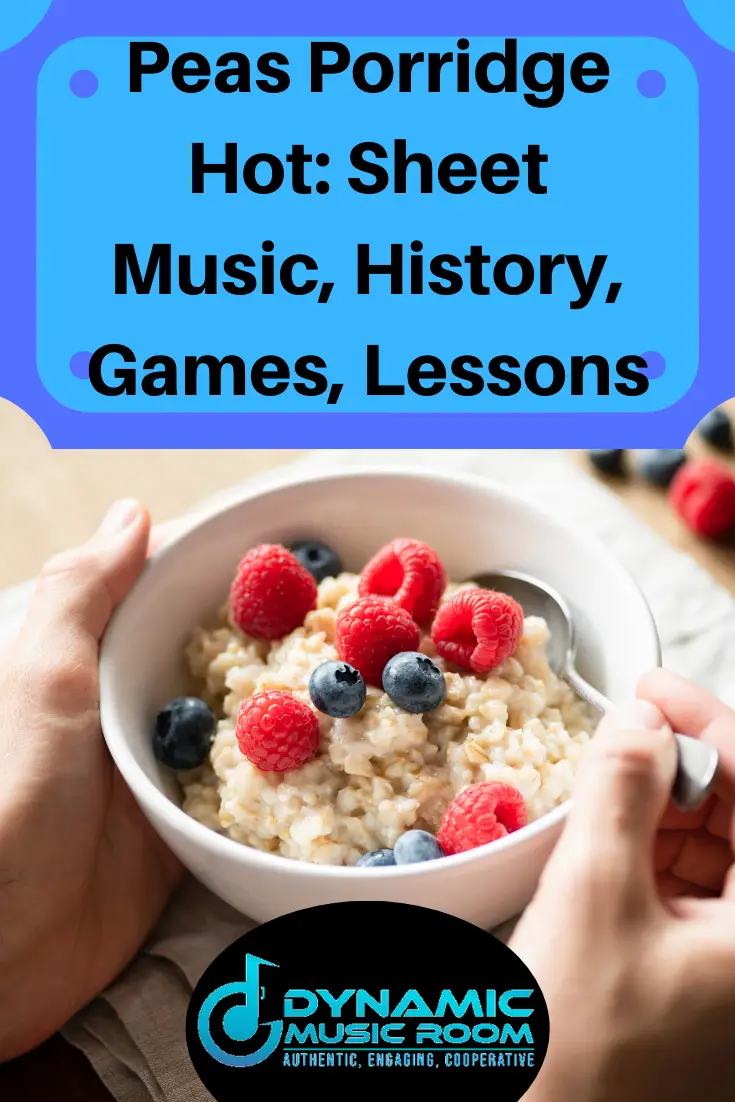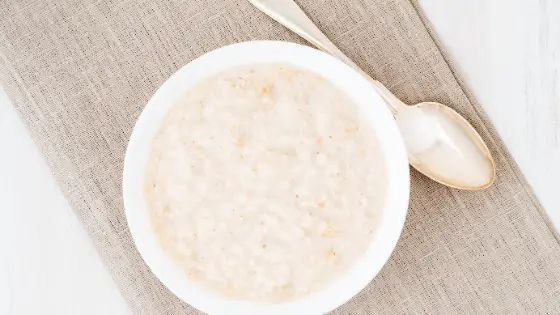Do you want to include more nursery rhymes in your teaching?
Are you looking for a simple clapping game to start with your younger students?
Nursery rhymes are an excellent source of folk song material to put in your music classroom repertoire.
One of the best and most classic ones is the chant, Peas Porridge Hot.
Peas Porridge Hot comes from England in the middle 1700s. The song is a simple children’s chant and clapping game perfect for introducing beat, rhythm, and pitch to younger students.
Read ahead for more details and a breakdown of the song.
Learn why folk songs are important.
Table of Contents
Peas Porridge Hot Sheet Music And Breakdown
Due to the nursery rhyme style, most older kids won’t go for this song. But my littles, especially preschool and Kindergarten, love it.
Pitches: Do, mi, sol (if using the melodic version)
Rhythms: Paired eighth notes, quarter rest, quarter note
Lyrics:
1. Peas porridge hot!
Peas porridge cold!
Peas porridge in the pot
Nine days old!
2. Some like it hot.
Some like it cold.
Some like it in the pot
Nine days old.
Origin: Mother Goose’s Melody by John Newbery, 1761. See more information below.
Peas Porridge Hot History
The exact origins of the song are unclear. The earliest mention of the rhyme is in Mother Goose’s Melody by John Newbery in 1761.
This does indicate the rhyme is likely older than this.
Unlike most nursery rhymes and folk songs from hundreds of years ago, this one has remained almost perfectly intact.
There are three main differences to point out.
Pease or peas
The song originally comes from Middle English. In Middle English, the mass singular form of pea is pease.
For help understanding this, think about the word “oatmeal.” You have a bowl of oatmeal which contains many oats.
A group of peas or a bowl of peas (from the modern version) was called a bowl of pease.
Multiple bowls of peace were called peasant.
The sound of pease and peas is the same, so over time, it adapted to be just peas.
Second stanza
In the original, the second stanza is different.
Original:
Spell me that
In four letters
I will
T-H-A-T
Modern:
Some like it hot.
Some like it cold.
Some like it in the pot
Nine days old.
Addition of melody
Of course, the original nursery rhyme was just that: a rhyme.
No melody was notated, and it’s unknown if it was sung or sing-chanted at the time.
As the centuries have gone by, music teachers have added a melody based on what students and people have sung/chanted.
The current version of this was written down in The Oxford Dictionary of Nursery Rhymes in 1952. This is the sheet music version included above.
Pease Porridge Hot Game: 2 Versions
The game for Peas Porridge Hot is a simple clapping one. There are two main versions out there.
Likely there are many more, but most sources agree with these two as the most common.
Both versions of this game use a partner where both partners are facing each other either standing or sitting.
Beat Clapping Pattern
This game is focused on the beat. Students will do the pattern on repeat to the beat while the rhyme is sung or chanted.
These moves help reinforce steady beat and are a perfect introduction to basic clapping game moves.
On each beat:
- Pat own lap
- Clap own hands
- Clap partner’s hands
- Back to clapping own hands
And repeat until the song is done.
Traditional Rhythm Clapping Pattern
The traditionally accepted pattern matches the rhythm of the words. The moves involved are as follows:
- Pat own lap (P)
- Clap own hands (X)
- Clap both partner’s hands (B)
- Right hand clap with partner (R)
- Left Hand clap with partner (L)
The order matches the beat, but you change the number of times you do the move based on the number of syllables in the beat.
Use the shorthand notes in parentheses above to better align with the sheet music if you’re having trouble imagining it.
Here are the moves (note the “z” stands for rest and doesn’t do any move):
- P CC R z
- P CC L z
- P CC RR C
- L C P z
This game is a little more difficult than the beat one as it uses more moves and matches the words rather than the beat.
On top of this, the pattern changes rather than just repeating.
Don’t get frustrated if your youngsters struggle with this at first. Just break it down and give them a lot of slow practice.
It’s so much fun once they get it. Believe me!
Which Should You Do?
This largely depends on your students. If you’re doing preschool music with this rhyme, you should start with the beat game for sure.
For Kindergarten, if this is their first experience with clapping games, start with the beat game and graduate to the traditional version later on in the year.
On the other hand, classes with clapping game experience may have no difficult jumping right into the traditional rhythm clapping game.
It’s ultimately up to you and what your students can handle.

Pease Porridge Hot Lesson: Quarter Rest
Many lessons may be drawn from this rhyme, but quarter rest is one of the earliest ones I focus on with this song (after steady beat of course).
Grade: End of Kindergarten, early first grade
Concepts: Quarter rest
Behavioral Objectives:
- Students will be able to show with their bodies where the rests occur in this rhyme with 80% accuracy.
- Students will be able to work in groups to arrange patterns with rest using manipulatives and perform them to the teacher with 80% accuracy.
Materials Needed: Paper plates (4 for each group, one side has a star drawn on it, one side has a z)*
*The images may be replaced with actual notation if the teacher wishes.
Assessment:
The teacher will monitor during the early part of the lesson to watch for students to indicate a quarter rest with a shrugging motion.
The teacher will assess each small group’s understanding by their ability to accurately perform the patterns they create using the paper plates.
Procedure:
- Class finished singing Peas Porridge Hot and playing the clapping game (the traditional rhythm one preferably).
- The teacher points out that there were some places in the music where the words and clapping took a break.
- Ask students to shrug when they get to a place where the teacher’s voice stops saying the rhyme.
- Monitor and provide feedback.
- Ask students to think on their own and count how many of these silent spots there were in the song.
- Show with their fingers. Look for answers.
- Ask the class to close their eyes and sing the song together. They should indicate the silent spot with a shrug.
- Assess.
- Explain that in music this is called a rest. We can show it with a “z” (or the real note if you’re ready for it).
- Write the pattern star-star-star-z on the board. Ask students to say this pattern with a syllable (ta or something else) for the star and shrug for the z.
- Split class into groups of 2-3. Explain directions for creating their own patterns they need to practice saying.
- Make it clear you’ll be coming around to check their work.
- Hand out paper plates
- **Make sure you review group work procedures.
- Assess students in small groups throughout the time.
- Collect the paper plates while the students hum the song.
- After all is collected, ask for students to explain in their own words what they think a rest is in music.
Conclusion
I hope you enjoyed learning a little more about how to use Peas Porridge Hot.
My youngest students love to play the simple clapping game, and I love how it reinforces concepts such as steady beat, basic rhythms, and introduces clapping games.
If you like this article, you may also like 17 folk songs every kid should know.

